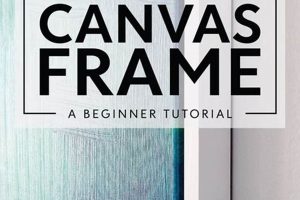The construction of a borderless display for stretched artwork, achieved through do-it-yourself methods, provides a visually distinct presentation. This approach involves creating a frame that seemingly levitates the canvas, separating it from the surrounding structure with a narrow gap. A typical execution involves building a wooden frame slightly larger than the canvas, attaching the canvas from the back, leaving a small reveal that gives the illusion of floating.
This method offers an elevated aesthetic compared to traditional framing, lending a contemporary and gallery-like feel to artwork. Its benefits include enhanced focus on the art itself, a cleaner presentation, and potential cost savings compared to professional framing services. The technique has gained popularity as individuals seek personalized and economical ways to display their artwork, mirroring a broader trend towards customized home decor solutions and accessible art presentation.
The subsequent discussion will elaborate on the materials required, the step-by-step process of frame construction, and various techniques for mounting the canvas within the frame to achieve the desired floating effect. Considerations for wood selection, accurate measurements, and securing the canvas will also be addressed.
Essential Considerations for Borderless Canvas Framing
The following guidelines offer practical advice for successfully executing a borderless canvas frame project, ensuring both structural integrity and aesthetic appeal.
Tip 1: Accurate Measurement is Paramount. Precise measurements of the canvas are essential before frame construction. Ensure the frame is slightly larger than the canvas dimensions, typically by a quarter to a half inch on each side, to create the desired floating gap.
Tip 2: Wood Selection Matters. Choose straight, unwarped lumber for the frame. Softwoods like pine are often used due to their workability, but hardwoods such as poplar or maple provide increased durability and resistance to warping.
Tip 3: Mitered Corners Enhance Appearance. Utilize mitered corners (45-degree cuts) for a professional, seamless frame appearance. A miter saw or miter box can ensure accurate cuts.
Tip 4: Secure Fastening Prevents Instability. Employ wood glue and brad nails or screws to securely assemble the frame. Ensure the corners are square and properly aligned before the adhesive sets.
Tip 5: Adequate Support is Crucial. Consider adding corner braces or reinforcing blocks to the frame’s interior, especially for larger canvases, to enhance structural integrity and prevent sagging.
Tip 6: Proper Canvas Mounting is Key. Attach the canvas to the frame from the back using screws or strong adhesive. Ensure the canvas is centered and taut within the frame to maintain the floating illusion.
Tip 7: Finishing Touches Enhance Longevity. Apply a sealant or finish to the frame to protect the wood from moisture and wear. A coat of paint or stain can further customize the frame’s appearance.
Adherence to these tips increases the likelihood of a successful outcome, resulting in a visually appealing and structurally sound borderless canvas display.
These considerations, when combined with careful execution, provide a foundation for creating an attractive and durable presentation for stretched canvas artwork.
1. Accurate canvas dimensions
The execution of a successful borderless canvas frame is fundamentally reliant upon precise measurements of the canvas itself. Inaccurate dimensions introduce a cascade of complications that undermine the aesthetic and structural integrity of the finished piece. The frame’s internal dimensions must be determined by the canvas’s length and width, adding a consistent margintypically between 1/4 and 1/2 inchto create the illusion of suspension. A discrepancy, even marginal, will manifest as an uneven or nonexistent gap, negating the intended visual effect. For instance, if the frame is too small, the canvas will be pressed against its edges, eliminating the floating appearance. Conversely, an excessively large frame creates an obtrusive and disproportionate border, detracting from the artwork.
Consider a practical scenario: a canvas purportedly measuring 24×36 inches, but deviating by an eighth of an inch in either dimension, necessitates recalculation of the frame’s internal parameters. This seemingly minor error, if unaddressed, propagates through the entire construction process. The mitered corners, cut according to the incorrect dimensions, will not align properly, creating unsightly gaps. Furthermore, the mounting hardware, positioned based on the inaccurate measurements, may fail to secure the canvas evenly, resulting in sagging or warping. Art galleries and museums, often employing borderless frames for their exhibits, understand that meticulous attention to dimensional accuracy is vital for achieving a professional and refined display. Their preparators often use laser measuring tools to ensure the canvas dimensions and frame match, as slight misalignments may detract from the artwork presentation.
In summary, the accuracy of canvas dimensions is not merely a preliminary step but an indispensable prerequisite for realizing the visual goals of a borderless frame. The precision is essential to achieve the intended aesthetic, ensuring that the artwork is displayed in a manner that enhances its impact without detracting from its inherent qualities. Overlooking this aspect compromises the entire endeavor, resulting in a substandard presentation. Understanding and addressing this relationship is, therefore, critical for anyone attempting to construct a borderless frame for a stretched canvas.
2. Frame Material Selection
The choice of material fundamentally dictates the structural integrity, aesthetic character, and overall longevity of a borderless canvas frame project. Selecting an appropriate material involves weighing factors such as cost, workability, durability, and the desired visual effect.
- Wood Type and its Impact on Structural Stability
Different wood species exhibit varying degrees of strength, resistance to warping, and susceptibility to moisture. Softwoods like pine are cost-effective and easy to work with but may lack the rigidity required for larger frames, increasing the risk of sagging over time. Hardwoods such as oak, maple, or walnut offer superior strength and stability but are more expensive and require specialized tools for accurate cutting and joinery. Selecting a wood that balances workability with structural demands is critical for ensuring the frame remains true to its dimensions over extended periods. A frame constructed from improperly dried softwood, for example, might twist or warp, compromising the “floating” effect.
- Material Weight and its Effect on Hanging Considerations
The weight of the frame material directly influences the hanging hardware and wall support required. A frame constructed from dense hardwood, especially for a larger canvas, can be significantly heavier than one made from lightweight materials like basswood or foam board. This necessitates the use of heavier-duty hanging hardware and potentially reinforcement of the wall structure, particularly when dealing with drywall. Failure to account for the weight of the material can lead to instability and potential damage to the artwork or the surrounding environment. Professionals frequently use lighter wood and specialized hangers for large pieces of art.
- The Influence of Material on Aesthetic Appeal
The frame material is integral to the overall visual presentation of the artwork. Different wood types offer distinct grain patterns and color tones that can complement or contrast with the canvas. A rustic, reclaimed wood frame might suit a landscape painting, while a sleek, minimalist frame crafted from painted MDF (Medium-Density Fiberboard) could enhance a contemporary abstract piece. The finish applied to the material, whether it is a clear coat, stain, or paint, further influences the aesthetic. The frame becomes a cohesive component of the artwork, and a material selected should be reflective of the art.
- Material Cost and Accessibility
Material cost is a pragmatic consideration that impacts project feasibility. Exotic hardwoods or specialized metals drastically increase the expense of the frame. In contrast, readily available materials like pine, fir, or MDF provide more economical options. The cost should be balanced against the desired aesthetic and functional qualities. Furthermore, accessibility to materials impacts the overall ease and speed of the construction process. Locally sourced lumber or materials available at a nearby hardware store simplify the project’s logistics.
Frame material selection is a complex decision-making process with far-reaching implications for the “floating frame canvas diy” project. The selected material not only provides the structural foundation but also contributes significantly to the aesthetic character, stability, and longevity of the framed artwork. A thorough understanding of material properties and their implications will ultimately yield a more successful outcome. Using the correct materials greatly increases the chance of a professional looking final product.
3. Precise mitered corners
The successful execution of a “floating frame canvas diy” project is inextricably linked to the precision of the mitered corners. These 45-degree angled cuts, when joined, form the four corners of the frame, and any deviation from accuracy significantly compromises both the structural integrity and aesthetic appeal of the final product. Imprecise miters result in visible gaps, uneven frame dimensions, and a weakened overall structure, detracting from the illusion of the canvas floating within the frame. The desired effect relies on a seamless, continuous border around the canvas, a goal unattainable without meticulously crafted corners.
Consider the practical ramifications of imprecise miters. Gaps at the corners, even fractions of an inch, disrupt the visual flow and draw unwanted attention to the frame itself, distracting from the artwork. Furthermore, misaligned corners create unequal frame dimensions, leading to a distorted presentation. In the context of a floating frame, where the intention is to minimize the frame’s visual presence, such flaws become glaringly apparent. For example, a frame with uneven corners may not sit flush against a wall, creating shadows and further emphasizing the imperfections. Professionals employ specialized tools, such as miter saws with digital angle readouts, to ensure accuracy within a fraction of a degree, understanding that even slight deviations have a disproportionate impact on the final outcome.
In summary, precise mitered corners are not merely a detail but a foundational element of a successful “floating frame canvas diy” project. Accuracy in these cuts directly translates to a seamless, visually appealing, and structurally sound frame, allowing the artwork to take center stage. The challenges associated with achieving perfect miters underscore the need for meticulous technique, appropriate tools, and a clear understanding of the critical role these corners play in the overall design. Overlooking this aspect inevitably leads to a compromised presentation and undermines the intended effect of the floating frame.
4. Secure canvas mounting
The process of canvas mounting is integral to the success of a “floating frame canvas diy” project. Secure attachment ensures the canvas remains properly positioned within the frame, maintaining the desired aesthetic and preventing potential damage. Insufficient mounting can lead to canvas slippage, sagging, or warping, compromising the intended floating effect and detracting from the artwork’s presentation. Consider, for instance, a scenario where the canvas is attached to the frame using inadequate adhesive. Over time, gravity and environmental factors such as temperature fluctuations may cause the adhesive to fail, resulting in the canvas separating from the frame and losing the intended suspension effect. Proper mounting techniques address these concerns.
Various methods exist for securing the canvas, each with its own advantages and drawbacks. Offset clips, strategically positioned around the perimeter of the canvas, provide a mechanical means of attachment, distributing the load and preventing uneven stress. Screws, driven through the frame into the stretcher bars of the canvas, offer a more robust connection, particularly for larger or heavier pieces. Adhesive bonding, using specialized archival-quality adhesives, can create a seamless and unobtrusive attachment. Regardless of the chosen method, even tension is vital. Uneven mounting can warp or distort the canvas, affecting its visual appearance and potentially causing long-term damage. Museums and galleries commonly employ experienced art handlers who understand the nuances of canvas mounting, often using a combination of techniques to ensure both security and preservation.
In summary, the secure mounting of the canvas is a critical component of any “floating frame canvas diy” project. Improper or inadequate mounting undermines the intended aesthetic, compromises the structural integrity, and potentially damages the artwork. Employing appropriate techniques and materials, guided by an understanding of the forces at play, is essential for achieving a visually appealing and long-lasting display. The effort invested in this stage directly contributes to the overall success of the project, ensuring that the artwork is presented in a manner that respects its value and artistic merit.
5. Aesthetic gap consistency
In the context of creating a borderless canvas display through do-it-yourself methods, uniformity in the space between the canvas edge and the inner frame edge exerts significant influence on the final visual outcome. The dimension of this reveal, typically a narrow margin of a quarter to a half inch, dictates the perceived ‘floating’ effect. Variations in this distance disrupt the intended illusion, resulting in a less refined, potentially amateurish presentation. For example, a frame exhibiting a gap of 1/4 inch on one side and 3/8 inch on another lacks visual harmony, drawing attention away from the art itself and towards the inconsistencies of the frame. This deviation becomes especially noticeable in minimalist artwork or when the frame is viewed from an angle.
Achieving consistent spacing necessitates precise measurements and careful assembly techniques. Using spacers or shims during the mounting process aids in maintaining a uniform gap while securing the canvas to the frame. Meticulous attention must be paid to ensuring the canvas is centered within the frame, as even slight misalignments translate into noticeable variations in the gap. Professional framing services often employ laser alignment tools and specialized jigs to guarantee dimensional accuracy and uniformity. This precision is crucial in galleries and museums where the presentation of artwork must meet exacting standards. Deviations can visually detract from the artist’s work.
The consistent reveal is more than an aesthetic preference; it serves to isolate and emphasize the artwork, enhancing its perceived value and impact. Inconsistent spacing introduces visual noise, distracting from the intended focal point. The challenge in a do-it-yourself context lies in replicating the precision of professional framing techniques with readily available tools and materials. However, by prioritizing accuracy in measurement and employing careful assembly practices, individuals can achieve a level of aesthetic gap consistency that elevates the overall presentation of their artwork, producing results that closely approximate professional standards.
Frequently Asked Questions
This section addresses common inquiries and misconceptions surrounding the creation of borderless frames for stretched canvas artwork. The intent is to provide clarity and guidance for individuals undertaking these projects.
Question 1: What specific tools are indispensable for creating a borderless frame?
A miter saw, or a hand saw with a miter box, is crucial for accurate corner cuts. Precision measuring tools, such as a steel ruler or digital caliper, are necessary for ensuring dimensional accuracy. Clamps are required for securing the frame during assembly, and a drill or screwdriver is needed for fastening the canvas. Safety glasses and hearing protection are recommended throughout the process.
Question 2: What type of adhesive is appropriate for mounting the canvas to the frame?
Archival-quality, pH-neutral adhesives are recommended to prevent long-term degradation of the canvas. Avoid adhesives containing solvents or acids that could damage the artwork. Options include acrylic-based adhesives or specialized canvas mounting tapes. Test the adhesive on a small, inconspicuous area of the canvas before full application.
Question 3: How can warping of the wooden frame be prevented?
Select kiln-dried lumber that has been properly seasoned to minimize moisture content. Avoid storing the wood in excessively humid or dry environments. Apply a sealant or finish to the frame to protect it from moisture absorption. For larger frames, consider using thicker lumber or adding internal bracing to increase structural rigidity.
Question 4: What is the optimal gap size between the canvas and the frame?
A gap of approximately 1/4 to 1/2 inch is generally considered aesthetically pleasing, providing a subtle separation between the canvas and the frame. The exact dimension is a matter of personal preference, but maintaining a consistent gap around the entire perimeter is crucial for a professional appearance.
Question 5: How should the canvas be prepared before mounting it into the frame?
Ensure that the canvas is properly stretched and free from wrinkles or sags. Clean the surface of the canvas to remove any dust or debris. If necessary, lightly dampen the back of the canvas to tighten the weave, allowing it to dry completely before mounting.
Question 6: Is it possible to adapt this technique for canvases of irregular shapes?
Creating borderless frames for non-rectangular canvases presents unique challenges. The frame must be custom-cut to match the canvas’s contours, requiring advanced woodworking skills and specialized tools. Templates and precise measurements are essential for achieving a seamless fit. Consider consulting with a professional framer for complex shapes.
The responses provided offer a foundation for addressing common concerns associated with the creation of floating frames. Prior planning and research are crucial for success. Consider seeking professional help to enhance the final product.
The subsequent section will detail the benefits that this “floating frame canvas diy” brings.
Conclusion
This exploration of borderless canvas frame construction has illuminated the critical elements necessary for successful execution. From precise measurement and material selection to meticulous corner joinery and secure canvas mounting, each step demands attention to detail. The establishment of a consistent aesthetic gap is paramount in achieving the desired illusion of suspension, elevating the artwork’s visual impact.
The pursuit of creating a borderless display provides individuals with a pathway to customize their artistic presentations. The information presented serves as a foundation for undertaking such projects, promoting thoughtful planning and careful craftsmanship. Continued refinement of these techniques ensures aesthetically pleasing and structurally sound results, enhancing the appreciation of the art itself.







